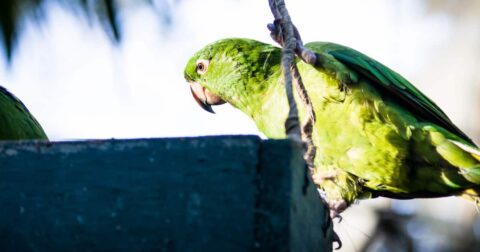Southwest Wisconsin Dairy Operation Linked to Spill Affecting Eight Miles of Trout Waters
Climate•4 min read
The illicit trade in wild birds, particularly scarlet macaws and yellow-naped parrots, has put many native species at risk of extinction.


Words by Isabella Rolz
For centuries, parrots of the family Psittacidae of Central America have been considered excellent pets, either because of their color, ability to speak, or easy adaptation to domestic life. But this has led to a lucrative illicit trade in the birds, particularly scarlet macaws and yellow-naped parrots. To make matters worse, when these species are transported from the area whey they are stolen to the selling locations, an approximate 80 percent die because of the conditions in which they are being carried, according to Fernando Martínez, director of ARCAS, a Guatemalan nonprofit organization that protects wildlife animals.
Additionally threatened by habitat loss, due mainly to unlawful logging of forests, the growth of the agricultural frontier, and urban population density, the population of Psittacidae parrots has fallen by almost 90 percent. In the case of the scarlet macaws, there are approximately 1,000 left, according to WCS Guatemala. For the yellow-naped parrots, the International Union for Conservation of Nature (IUCN) declared the species critically endangered after its number was reduced alarmingly in 2020.
In the wild, the parrots look for tall, isolated trees or palm trees for nesting, and their diet consists of fruits, nuts, and seeds, which means that their habitat must meet their nutritional needs. As a result, they are strong fliers that travel long distances searching for food. This allows the parrots to play the crucial role of seed dispersers, contributing to various tree species’ regeneration.
The significant destruction of their habitat due to cultivation, hunting, and trafficking indicates a reduction of more than 40 percent of the species, according to Norlan Zambrana, Vice President of the Biometepe Cooperative in Nicaragua.
Despite them being on the brink of extinction, there is hope. Currently, several organizations across the region are working to protect and conserve both species. Through community-based efforts, which include the protection of the animal’s wellbeing, and environmental education programs that teach locals about the importance of preserving the species for the forest’s health, these institutions are fighting against their extinction.
The Loro Parque Fundación, based in Tenerife, Spain, has been operating in Central America since 1994 and has invested close to one million dollars to conserve parrot species. “Through research, local communities are involved in surveys, and environmental education plays a vital role in our projects. Many of the children who received our training over the last 20 years are now actively involved as professionals in our field projects,” said Rafael Zamora, Director of the organization.
Norlan Zambrana, Vice President of the Biometepe Cooperative that operates on the island of Ometepe in Nicaragua, said that once he saw that there was potential they started organizing themselves to educate “the community members, specifically the species’ poachers, to teach them that it was not appropriate to be plundering the nests. We let them know that stealing the eggs is counterproductive for the conservation of the species,” he said. Now, Biometepe provides support to protect the approximately 100 active nests in each of the six communities on the island.
Biometepe visits community members and properties where the species puts its nests. “Our operation consists of three phases; first, we identify the nest, and climb the trees to see if it is active. Then we talk to the property owner and agree that if they accept to protect the nest, we give them a small incentive. For example, if their farm needs to fence an area or other material for their property, we give them the material as an incentive,” Zambrana said.
However, because of the pandemic, Nicaragua is struggling with employment opportunities, and people are plundering and selling parrots. “These give economic profit to the struggling families, so we are working on intensifying our awareness efforts and environmental education programs to promote the conservation of this species.”
In Guatemala, the National Council for Protected Areas (CONAP), a governmental initiative aimed at protecting the yellow-naped parrot from extinction, has installed ten artificial nests in 2022 as part of a pilot program to compensate for the loss of the species’ habitat and nesting sites.
In Costa Rica, Macaw Recovery Network recently trained seven women in the areas of habitat restoration, environmental education, and the monitoring of the scarlet macaws and other wild species. “The Women Rangers Program” started as an initiative to empower local women who lost their jobs due to COVID-19. “They are currently working on building a tree nursery in their hometown, which could spark conversation with their neighbors about the importance of restoring habitat,” said Carey Wentz, Communications Manager at Macaw Recovery Network.
As macaws are seed dispersers, “by protecting them and restoring their populations, they can contribute to the growth of plants in their habitat,” said Wentz. This is why Macaw Recovery Network shows “local communities the beauty of these birds that are native to their lands and show[s] them what they would be missing if they became extinct. The protection of one species often ends up protecting others in its habitat. Everything is connected,” she added.
The fight against illegal trafficking and the protection of ecosystems is expensive, and the region’s governments, in general, lack the interest to allocate economic resources for it. With that in mind, in 2020, a group of Central American conservationists and researchers devised the creation of an entity that would help unite regional efforts and create a cross-border space in which experiences, concerns, and opportunities are shared.
“We sought to centralize efforts, since in different countries there are different initiatives, in different contexts, that can be of great use to those who protect Psittacidae,” said Martín Lezama, Director of Loros Sin Fronteras, a network responsible for disseminating educational information about parrots and macaws endemic to the region, with members from Mexico, Central American countries, Cuba, Puerto Rico, and the Dominican Republic. “We are looking to ally ourselves with organizations from Panama and the Guyanas,” added Lezama.
Cross-border work is indeed the most effective route to combat the threats that wildlife species face. According to a report published by the WCS in 2018 on lessons learned, the strengthening of community leadership and the creation and implementation of transnational and inter-institutional policies are crucial to reversing the current reality. “Civil society must take the lead in efforts to combat illegal trafficking of wildlife when government commitment and/or capacity is low,” the environmental entity concluded.